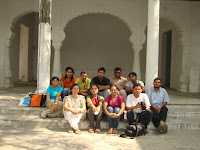


Walking down the lanes of the old city of Hyderabad can be either a nightmare or an adventure, and of course one of the many variants and mixtures in between. If you live or work in Lad Bazaar or Patthergatti of course, it's no more than routine. A group of uncomplaining (actually, enthusiastic) students from the MA-Communication program at the University of Hyderabad agreed to join me on a walk through the old city, giving up a precious Sunday of sleeping in. The Heritage Walk conducted by Andhra Pradesh Tourism invites one to discover history in the routine, by unpacking for the unfamiliar walker, the layers of history that lie beneath the grimy walls of these crowded, dilapidated, yet vibrant marketplaces. Beginning at Charminar, the 16th century monument that has come to symbolise the city's heritage, the walk takes you through the lane known variously as "Lad Bazaar" (the market place of indulgence) or Chudi Bazaar (bangle market). The early morning commencement saves the walkers from the hawkers and the enthusiastic bangle and ittar sellers, and allows you to glimpse under the garishly painted awnings, a bit of the outermost walls, now destroyed, of the Chowmahalla Palace complex. Our walk, on April 11, was led by the articulate and knowledgeable Manisha Gadhalay, who peeled away the present to show us what the area may have looked and felt like when the Qutb Shahis and Asaf Jahis (dynasties that ruled Hyderabad between the 14th and 20th centuries) held court.
I've been through the old city, and this route, many times, and each time I cannot hold the excitement I feel when I notice a small piece of stucco work I had not seen before, or catch a sense of space that tells me something about how life was lived. And when you share this love of a city that has grown on you, with a group of young and receptive minds, it's doubly exciting. Cameras clicked and notes were taken as Manisha led us through Lad Bazaar to the north wall of Mecca Masjid, then again through what used to be the jilau-khana (stables) to Mahbook Chowk and the 19th century clock tower that is now surrounded by a bird market, locksmiths selling every conceivable shape and size of lock, a maze of meat stalls, to the front courtyard of what remains of a once grand deorhi. Then out again, to walk down another pathway to Kurshid Jah's baradari, its large compound now taken over by Sunday cricket teams and footballers, to a brief pause in the archways of the grand portico, now watched over by a family of goats and a woman cooking the morning meal in what may have once been a mirrored parlour, an aina-khana.
Bemoaning the disappearing sense of historicity, we pass a tight discussion group who turn out to be members of a civic group interested in the preservation of the heritage sites in the old city. Hope, maybe?
Manisha points out the front of another mansion--a panel beneath the roof holds symbols of a cultural unity; the face of Surya and the crescent of Islam. And finally, the gates of Chowmahalla, the complex of four palaces that housed the Hyderabadi royalty. The Chowmahalla has been written about extensively in recent times, interest in its treasures renewed when Princess Esra, wife of the older grandson of the seventh and last Nizam, decided to throw open its gates to the public and restore its interiors. Restoration is a work in progress, and every visit reveals a new facet of a culture overtaken by time. The Heritage Walk ends with breakfast in one of the shaded courtyards of the palace, and Manisha leaves us with some final stories of the old city, and a desire to see more, learn more.
So we decided not to stop there, and continue, a few days later, with a visit to the Paigah Tombs, another forgotten landmark on the map of the old city. But that's another story.
Comments